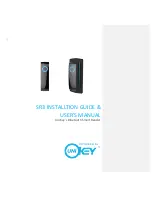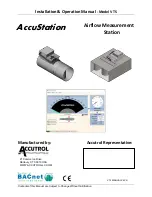
Multicasting
A multicast may only be used in UDP/IP and is similar to a broadcast (where everyone on the network gets the
information) but specific to a group. In other words, all devices within a specified group will receive the
information that is sent in a multicast. There can be many multicast groups on a network and are differentiated by
their multicast IP address. To communicate with all the devices in a specific multicast group, the information can
be sent to the multicast IP address rather than to each individual device IP address. All Galil controllers belong to a
default multicast address of 239.255.19.56. The controller's multicast IP address can be changed by using the IA> u
command.
Using Third Party Software
Galil supports DHCP, ARP, BOOT-P, and Ping which are utilities for establishing Ethernet connections. DHCP is a
protocol used by networked devices (clients) to obtain the parameters necessary for operation in an Internet
Protocol network. ARP is an application that determines the Ethernet (hardware) address of a device at a specific
IP address. BOOT-P is an application that determines which devices on the network do not have an IP address and
assigns the IP address you have chosen to it. Ping is used to check the communication between the device at a
specific IP address and the host computer.
The DMC-42x0 can communicate with a host computer through any application that can send TCP/IP or UDP/IP
packets. A good example of this is Telnet, a utility that comes with most Windows systems.
Modbus
An additional protocol layer is available for speaking to I/O devices. Modbus is an RS-485 protocol that packages
information in binary packets that are sent as part of a TCP/IP packet. In this protocol, each slave has a 1 byte slave
address. The DMC-42x0 can use a specific slave address or default to the handle number. The port number for
Modbus is 502.
The Modbus protocol has a set of commands called function codes. The DMC-42x0 supports the 10 major function
codes:
Function Code
Definition
01
Read Coil Status (Read Bits)
02
Read Input Status (Read Bits)
03
Read Holding Registers (Read Words)
04
Read Input Registers (Read Words)
05
Force Single Coil (Write One Bit)
06
Preset Single Register (Write One Word)
07
Read Exception Status (Read Error Code)
15
Force Multiple Coils (Write Multiple Bits)
16
Preset Multiple Registers (Write Words)
17
Report Slave ID
The DMC-42x0 provides three levels of Modbus communication. The first level allows the user to create a raw
packet and receive raw data. It uses the MBh command with a function code of –1. The format of the command is
MBh = -1,len,array[] where len is the number of bytes
array[] is the array with the data
The second level incorporates the Modbus structure. This is necessary for sending configuration and special
commands to an I/O device. The formats vary depending on the function code that is called. For more information
refer to the Command Reference.
Chapter 4 Software Tools and Communication ▫ 41
DMC-42x0 User Manual
Содержание DMC-42 0 Series
Страница 85: ...Chapter 6 Programming Motion 81 DMC 42x0 User Manual Figure 6 14 ECAM cycle with Z axis as master...
Страница 195: ...ICM 2900 PCB Layout Appendices 191 DMC 42x0 User Manual...
Страница 205: ...CB 50 100 Drawings Appendices 201 DMC 42x0 User Manual...
Страница 206: ...Appendices 202 DMC 42x0 User Manual...
Страница 207: ...Appendices 203 DMC 42x0 User Manual...
Страница 208: ...Appendices 204 DMC 42x0 User Manual...
Страница 209: ...Appendices 205 DMC 42x0 User Manual...
Страница 210: ...Appendices 206 DMC 42x0 User Manual...
Страница 211: ...Appendices 207 DMC 42x0 User Manual...
Страница 214: ...CB 50 80 Drawing Appendices 210 DMC 42x0 User Manual...
Страница 215: ...Appendices 211 DMC 42x0 User Manual...
















































